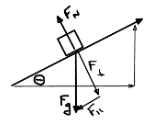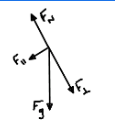Chapter 4 Test
1/36
Earn XP
Name | Mastery | Learn | Test | Matching | Spaced |
|---|
No study sessions yet.
37 Terms
Forces
pushes or pulls on an object
Contact Forces
there needs to be contacts for the force to cause motion; ex: friction, lift, air resistance
Non-Contact Forces
no contact is necessary for motion to occur; ex: gravity, magnetism
Newton’s 1st Law of Motion name
Law of Inertia
Newton’s 1st Law of Motion stated
an object in motion will remain in motion, an object at rest will remain at rest, unless acted upon by a net external force
Newton’s 1st Law of Motion net force
ΣF; vector sum of all forces
Newton’s 1st Law of Motion mass
intrinsic value that is a quantitative measure of inertia (doesn’t change based on where we are)
Newton’s 1st Law of Motion Inertia
tendency for an object to remain in its state of either motion or rest
Newton’s 2nd Law of Motion name
Law of Acceleration
Newton’s 2nd Law of Motion Stated
when a net external force, ΣF, is applied to a mass, m, it imparts acceleration a; ΣF=ma = kg*m/s² = Newton (N)
Newton’s 2nd Law of Motion units
Si- kg, m/s², Newton; CGS- gram, cm/s², dyme (dyn); BE- slug, ft/s², lb
Newton’s 2nd Law of Motion Free Body Diagram
diagram that represents the forces acting on a single object; place a dot to represent the object, construct an xy axis with the dot as the origin, and draw and label forces using size appropriate arrows
Newton’s 3rd Law of Motion name
Law of Reciprocal Actions
Newton’s 3rd Law of Motion stated
when one body exerts a force on another body, the second body exerts a force equal in magnitude but opposite in direction to first
Newton’s 3rd Law of Motion examples
swimming
Newton’s Law of Universal Gravitation stated
every particle in the universe exerts an attractive force on every other particle based on Fg= (G*m1m2)/r²
Newton’s Law of Universal Gravitation equation
Fg= (G*m1m2)/r²; Fg- force due to gravity; G- universal gravitational constant; m1- mass of object 1; m2- mass of object 2; r- distance between the object’s centers
Universal Gravitational Constant
6.67 × 10^-11 Nm²/kg²
Significance of [G(m/r²)]
acceleration due to gravity; determines the gravity of a planet; is Fg = m * g when objects are close to a planet’s surface
Pound → Newton
1 lb → 4.45N
Kilogram → Newtons
kg * gravity
Normal Force (FN)
a component of force that a surface in contact with something exerts perpendicular to itself; opposite of gravity; without it we would accelerate downwards; if resting on horizontal, non-accelerating surface, FN = Fg
Apparent Weight
weight displaed that is different than Fg that arises from either acceleration or a non-horizontal surface; FN= Fg + Fapplied = mg + ma; ex: elevator
Friction
component of force that acts parallel to a surface and opposes motion
Static Friction definition
Fs; force that must be overcome to set an object into motion; depends on coefficient of static friction and amount of Normal Force present
Static Friction equation
Fsmax = μs FN
Static Friction coefficient
μs; dependent on surfaces in contact
Kinetic Friction definition
Fk; force that must be overcome to keep an object in motion; depends on coefficient of kinetic friction and amount of Normal Force present
Kinetic friction equation
Fk= μK FN
Kinetic Friction coefficient
μK; dependent on surfaces in contat
Friction on an incline Fg ≠ FN
FN = F⊥

Fperpendicular (⊥)
= Fg cos()

Fparallel (∥)
=Fgsin()

sum of forces (ΣF) in equilibrium
ΣF = 0N; the object is either stationary or moving at a constant velocity
Acceleration in equilibrium
a = 0m/s²; the object is either stationary or moving at a constant velocity
sum of forces (ΣF) in non-equilibrium
ΣF ≠ 0N; the object is accelerating or decelerating
acceleration in non-equilibrium
a ≠ 0m/s²; the object is accelerating or decelerating